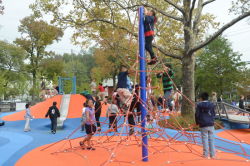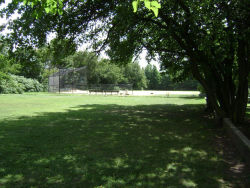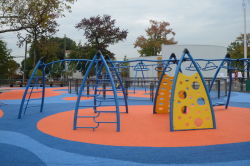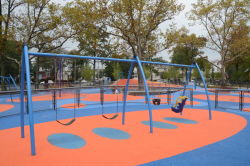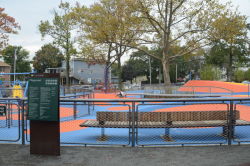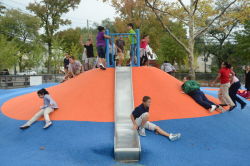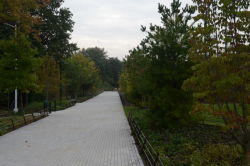Schmul Park
Shmul Playground
What was here before?
This playground is in Rego Park, a name derived from the Real Good Construction Company, which developed the neighborhood in the 1920s. The area was named by developers Henry Schloh and Charles I. Hausmann in 1923. Before the area was developed, it was farmland owned by Chinese immigrants. These Chinese farmers grew produce strictly for sale in Chinatown. In the 1920s, the Rego Construction Company bought out the farmers and built one-family row houses, multi-family houses, and apartment buildings.
How did this site become a playground?
The Board of Estimate approved the site for school and park purposes in 1954, and a joint-operation agreement was made later that year. Playground Sixty-Two serves the students and community of P.S. 220 in Rego Park, Queens. The park opened on May 8, 1957. Originally known as P.S. 220 Playground, it was renamed 62nd Road Playground by Parks in 1987, and Playground Sixty-Two in 1997, for the adjacent avenue and road.
The eastern side of the site has swings, play equipment with safety surfacing, and benches. The other is an open asphalt playground with basketball hoops, a baseball diamond with dugout benches, and a drinking fountain.
The playground was reconstructed in 2025 with multigenerational play areas, play panels, spray showers, and concrete step seating.
What is this playground named for?
Originally, street names in Queens were chosen by the community. There was no borough-wide unified street classification system. In 1898, after the consolidation of New York City, an effort began to organize names. In 1911, it was decided that the roadways would be numbered, with avenues, roads, and drives running east-west and streets, lanes, and places running north-south.
Roman numerals are a number system used in ancient Rome, using combinations of letters from the Latin alphabet. The basic numerals are I (1), V (5), X (10), L (50), C (100), D (500), and M (1000). Numbers are formed by adding or subtracting these values. For example, II represents 2, IV represents 4, and IX represents 9. Roman numerals are still used today in certain contexts, like in names of monarchs, for marking events or chapters and for the naming of this park.
Check out your park's Vital Signs
Clean & Safe
Green & Resilient
Empowered & Engaged Users
Share your feedback or learn more about how this park is part of a
Vital Park System

